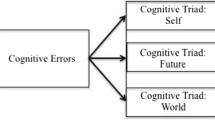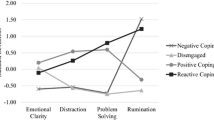Abstract
Integrations of cognitive models of depression, specifically, the hopelessness model (Abramson et al. Psychological Bulletin, 96, 358–372, 1989) and the response style theory (Nolen-Hoecksema et al. Journal of Abnormal Psychology, 101, 405–422, 1992) have been suggested but no previous study has compared the integrations of these models with each other and the original models. Further, previous studies only tested the associations between composite scores of inferences, from the hopelessness model, and rumination (incl. brooding and reflection), from the response style theory. Thus, a 3-wave study using self-report instruments with 519 adolescents was conducted (mean ageWave 1 = 16.09 years; SD = 0.70; 62.7% female; 72.8% European American, 14.7% African-American, 5.4% Latino, 4.4% mixed race/ethnicity, 1.4% Asian/Pacific Islander, 0.8% Native American, and 0.6% identified as “other”). The school serves predominantly working to middle class families and almost one third of the students were eligible for free or reduced lunch programs. AMOS and RMediation were used to calculate and compare five different theory-driven models. The findings of the study provide support for an integrated model in which both brooding and reflection are influenced by individual inferences and interact with individual inferences while affecting depressive symptoms. In addition, reflection plays an unexpectedly important role in this integrated model. Age and cognitive development are discussed as possible explanations for this finding.

Similar content being viewed by others

Notes
Robinson and Alloy (2003) measured rumination as proposed in the response style theory and stress-reactive rumination. While the first did not predict depression the latter did predict depression in this study.
The authors do not provide details about the associations in the mediation or moderation models. Thus, it does not add to the discussion about those models.
References
Abela, J. R., & Hankin, B. L. (2008). Handbook of depression in children and adolescents. New York: Guilford Press.
Abela, J. R. Z., Parkinson, C., Stolow, D., & Starrs, C. (2009). A test of the integration of the Hoplessness and response styles theories of depression in middle adolescence. Journal of Clinical Child and Adolescent Psychology, 38, 354–364.
Abramson, L. Y., Alloy, L. B., & Metalsky, G. I. (1989). Hopelessness depression: A theory-based subtype of depression. Psychological Bulletin, 96, 358–372.
Alloy, L. B., Abramson, L. Y., Hogan, M. E., Whitehouse, W. G., Rose, D. T., Robinson, M. S., Kim, R. S., & Lapin, J. B. (2000). The temple-Wisconsin cognitive vulnerability to depression project: Lifetime history of Axis I psychopathology in individuals at high and low cognitive risk for depression. Journal of Abnormal Psychology, 109, 403–418.
Arbuckle, J. L. (1999). Amos user’s guide. Chicago: SmallWaters.
Beck, A. T. (1976). Cognitive therapy and the emotional disorders. New York: International Universities Press.
Bentler, P. M. (1990). Comparative fit indexes in structural models. Psychological Bulletin, 107, 238–246.
Bufferd, S. J., Dougherty, L. R., Carlson, G. A., Rose, S., & Klein, D. N. (2012). Psychiatric disorders in preschoolers: Continuity from ages 3 to 6. American Journal of Psychiatry, 169, 1157–1164.
Ciesla, J. A., & Roberts, J. E. (2007). Rumination, negative cognition, and their interactive effects on depressed mood. Emotion, 7, 555–565.
Ciesla, J. A., Felton, J. W., & Roberts, J. E. (2011). Testing the cognitive catalyst model of depression: Does rumination amplify the impact of cognitive diatheses in response to stress? Cognition and Emotion, 25, 1349–1357.
Cole, D. A., & Maxwell, S. E. (2003). Testing mediational models with longitudinal data: Questions and tips in the use of structural equation modeling. Journal of Abnormal Psychology, 112, 558–577.
Cole, D. A., & Turner Jr., J. E. (1993). Models of cognitive mediation and moderation in child depression. Journal of Abnormal Psychology, 102, 271–281.
Cole, D. A., Ciesla, J. A., Dallaire, D. H., Jacquez, F. M., Pineda, A. Q., LaGrange, B., Truss, A. E., Folmer, A. S., Tilghman-Osborne, C., & Felton, J. W. (2008). Emergence of attributional style and its relation to depressive symptoms. Journal of Abnormal Psychology, 117, 16–31. https://doi.org/10.1037/0021-843X.117.1.16.
Collins, L. M., Schafer, J. L., & Kam, C.-M. (2001). A comparison of inclusive and restrictive strategies in modern missing data procedures. Structural Equation Modeling, 6, 330–351.
Gillham, J. E., Jaycox, L. H., Reivich, K. J., Seligman, M. E. P., & Silver, T. (1990). The Penn resiliency program. Unpublished manual, University of Pennsylvania, Philadelphia.
Gotlib, I. H., & Neubauer, D. L. (2000). Information-processing approaches to the study of cognitive biases in depression. In S. L. Johnson, A. M. Hayes, T. M. Field, N. Schneiderman, & P. M. McCabe (Eds.), Stress, coping, and depression (pp. 117–142). Mahwah: Lawrence Erlbaum Associates.
Graham, J. W. (2003). Adding missing-data-relevant variables to FIML-based structural equation models. Structural Equation Modeling, 10, 80–100.
Hankin, B. L., & Abramson, L. Y. (2002). Measuring cognitive vulnerability to depression in adolescence: Reliability, validity, and gender differences. Journal of Clinical Child and Adolescent Psychology, 31, 491–504. https://doi.org/10.1207/S15374424JCCP3104_8.
Hu, L., & Bentler, P. M. (1999). Cut-off criteria for fit indexes in covariance structure analysis: Conventional criteria versus new alternatives. Structural Equation Modeling, 6, 1–55.
Jacobs, R. H., Reinecke, M. A., Gollan, J. K., & Kane, P. (2008). Empirical evidence of cognitive vulnerability for depression among children and adolescents: A cognitive science and developmental perspective. Clinical Psychology Review, 28, 759–782. https://doi.org/10.1016/j.cpr.2007.10.006.
Kessler, R. C., Petukhova, M., Sampson, N. A., Zaslavsky, A. M., & Wittchen, H.-U. (2012). Twelve-month and lifetime prevalence and lifetime morbid risk of anxiety and mood disorders in the United States. International Journal of Methods in Psychiatric Research, 21, 169–184. https://doi.org/10.1002/mpr.1359.
Kline, R. B. (2015). Principles and practice of structural equation modeling. New York: Guilford Press.
Lakdawalla, Z., Hankin, B. J., & Mermelstein, R. (2007). Cognitive theories of depression in children and adolescents: A conceptual and quantitative review. Clinical Child and Family Psychology Review, 10, 1–24. https://doi.org/10.1007/s10567-006-0013-1.
Lo, C. S. L., Ho, S. M. Y., & Hollon, S. D. (2008). The effects of rumination and negative cognitive styles on depression: A mediation analysis. Behaviour Research and Therapy, 46, 587–495.
Mathews, A., & MacLeod, C. (1994). Cognitive approaches to emotion and emotional disorders. Annual Review of Psychology, 45, 25–50. https://doi.org/10.1146/annurev.ps.45.020194.000325.
Meade, A. W., Johnson, E. C., & Braddy, P. W. (2008). Power and sensitivity of alternative fit indices in tests of measurement invariance. Journal of Applied Psychology, 93, 568–592.
Mezulis, A., Simonson, J., McCauley, E., & Vander Stoep, A. (2011). The association between temperament and depressive symptoms in adolescence: Brooding and reflection as potential mediators. Cognition and Emotion, 25, 1460–1470. https://doi.org/10.1080/02699931.2010.543642.
Mills, K. L., Lalonde, F., Clasen, L. S., Giedd, J. N., & Blakemore, S. J. (2014). Developmental changes in the structure of the social brain in late childhood and adolescence. Social Cognitive and Affective Neuroscience, 9, 123–131. https://doi.org/10.1093/scan/nss113.
Nolen-Hoecksema, S., Girgus, J. S., & Seligman, M. E. P. (1992). Predictors and consequences of childhood depressive symptoms: A 5-year longitudinal study. Journal of Abnormal Psychology, 101, 405–422.
Nolen-Hoeksema, S., & Morrow, J. (1991). A prospective study of depression and posttraumatic stress symptoms after a natural disaster: The 1989 Loma Prieta earthquake. Journal of Personality and Social Psychology, 61, 115–121.
Pössel, P., & Winkeljohn Black, S. (2017). Can the hopelessness model of depression and the response style theory be integrated? Journal of Counseling and Development, 95, 180–191. https://doi.org/10.1002/jcad.12130.
Preacher, K. J., & Hayes, A. F. (2008). Asymptotic and resampling strategies for assessing and comparing indirect effects in multiple mediator models. Behavior Research Methods, 40, 879–891.
Radloff, L. S. (1977). The CES-D: A self-report symptom scale to detect depression in the general population. Applied Psychological Measurement, 3, 385–401.
Roberts, R. E., Lewinsohn, P. M., & Seeley, J. R. (1991). Screening for adolescent depression: A comparison of depression scales. Journal of the American Academy of Child & Adolescent Psychiatry, 30, 58–66. https://doi.org/10.1097/00004583-199101000-00009.
Robinson, M. S., & Alloy, L. B. (2003). Negative cognitive style and stress-reactive rumination interact to predict depression: A prospective study. Cognitive Therapy and Research, 27, 275–292.
Scher, C. D., Ingram, R. E., & Segal, Z. V. (2005). Cognitive reactivity and vulnerability: Empirical evaluation of construct activation and cognitive diatheses in unipolar depression. Clinical Psychology Review, 25, 487–510.
Spasojević, J., & Alloy, L. B. (2001). Rumination as a common mechanism relating depressive risk factors to depression. Emotion, 1, 25–37.
Steiger, J. H. & Lind, J. M. (1980, May). Statistically based tests for the number of common factors. Paper presented at the Psychometrika Society meeting, Iowa City, Iowa.
Tofighi, D., & MacKinnon, D. P. (2011). RMediation: An R package for mediation analysis confidence intervals. Behavior Research Methods, 43, 692–700.
Treynor, W., Gonzalez, R., & Nolen-Hoeksema, S. (2003). Rumination reconsidered: A psychometric analysis. Cognitive Therapy and Research, 27, 247–259.
Turner, J. E., & Cole, D. A. (1994). Developmental differences in cognitive diatheses for child depression. Journal of Abnormal Child Psychology, 22, 15–32.
Verstraeten, K., Vasey, M. W., Raes, F., & Bijttebier, P. (2010). Brooding and reflection as components of rumination in late childhood. Personality and Individual Differences, 48, 367–372. https://doi.org/10.1016/j.paid.2009.11.001.
Weiss, B., & Garber, J. (2003). Developmental differences in the phenomenology of depression. Development and Psychopathology, 15, 403–430.
Weitlauf, A. S., & Cole, D. A. (2012). Cognitive development masks support for attributional style models of depression in children and adolescents. Journal of Abnormal Child Psychology, 40(6), 849–862. https://doi.org/10.1007/s10802-012-9617-8.
Winkeljohn Black, S., & Pössel, P. (2013). The combined effects of self-referent information processing and ruminative responses on adolescent depression. Journal of Youth and Adolescence, 42, 1145–1154. https://doi.org/10.1007/s10964-012-9827-y.
Winkeljohn Black, S., & Pössel, P. (2015). Integrating Beck’s cognitive model and the response style theory in an adolescent sample. Journal of Youth and Adolescence, 44, 195–210. https://doi.org/10.1007/s10964-013-0087-2.
Zhao, X., Lynch, J. G., & Chen, Q. (2010). Reconsidering baron and Kenny: Myths and truths about mediation analysis. Journal of Consumer Research, 37, 197–206.
Author information
Authors and Affiliations
Corresponding author
Ethics declarations
Conflict of Interest
The authors declare that they have no conflict of interest.
Ethical Approval
All procedures performed in studies involving human participants were in accordance with the ethical standards of the institutional and/or national research committee and with the 1964 Helsinki declaration and its later amendments or comparable ethical standards.
Informed Consent
Informed consent was obtained from all individual participants included in the study.
Rights and permissions
About this article
Cite this article
Pössel, P., Pittard, C.M. Integrating the Hopelessness Model and the Response Style Theory in an Adolescent Sample. J Abnorm Child Psychol 47, 695–706 (2019). https://doi.org/10.1007/s10802-018-0465-z
Published:
Issue Date:
DOI: https://doi.org/10.1007/s10802-018-0465-z



